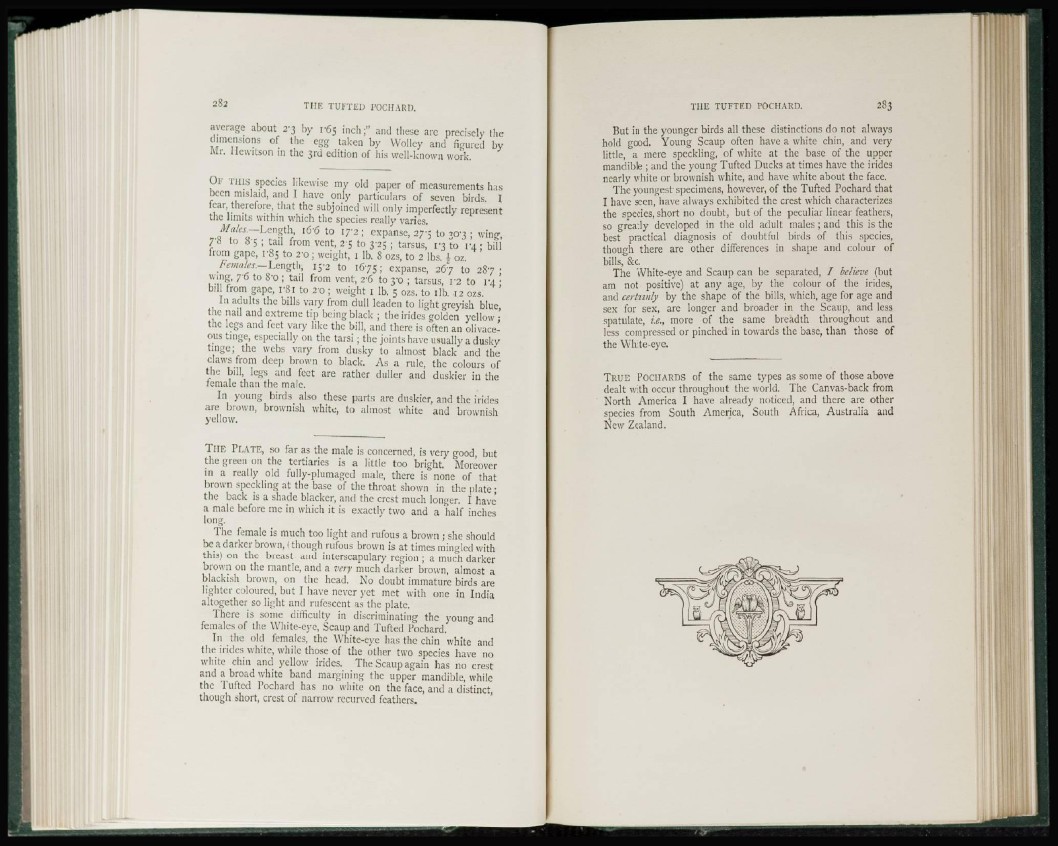
average about 2*3 by r 6 5 inch;" and these arc precisely the
dimensions of the egg taken by Wolley and figured by
Mr. Hewitson in the 3rd edition of his well-known work
OF THIS species likewise my old paper of measurements has
been mislaid, and I have only particulars of seven birds. I
fear, therefore, that the subjoined will only imperfectly represent
the limits within which the species really varies.
Males.—Length, 1&6 to 17-2 ; expanse, 27*5 to 30*3 ; wing,
7*8 to 85 ; tail from vent, 25 to 3-25 ; tarsus, 1*3 to 1*4; bill
from gape, 1-85 to 2*0; weight, 1 lb. S ozs, to 2 lbs. £ oz.
Females.—Length, 15*2 to 1675; expanse, 267 to 287;
wing, 7-6 to 8'0 ; tail from vent, 2-6 to 3*0 ; tarsus, 1*2 to 1*4 ;
bill from gape, I'SI to 2-0 ; weight 1 lb. 5 ozs. to lib. 12 ozs.
In adults the bills vary from dull leaden to light greyish blue,
the nail and extreme tip being black ; the irides golden yellow ;
the legs and feet vary like the bill, and there is often an olivaceous
tinge, especially on the tarsi; the joints have usually a dusky
tinge; the webs vary from dusky to almost black and the
claws from deep brown to black. As a rule, the colours of
the bill, legs and feet are rather duller and duskier in the
female than the male.
In young birds also these parts are duskier, and the irides
are brown, brownish white, to almost white and brownish
yellow.
T h e PLATE, so far as the male is concerned, is very good, but
the green on the tcrtiarics is a little too bright. Moreover
in a really old fully-plumaged male, there is none of that
brown speckling at the base of the throat shown in the plate ;
the back is a shade blacker, and the crest much longer. I have
a male before me in which it is exactly two and a half inches
long.
The female is much too light and rufous a brown ; she should
be a darker brown, I though rufous brown is at times mingled with
this) on the breast and intcrscapulary region ; a much darker
brown on the mantle, and a very much darker brown, almost a
blackish brown, on the head. No doubt immature birds arc
lighter coloured, but I have never yet met with one in India
altogether so light and rufesccnt as the plate.
There is some difficulty in discriminating the young and
females of the White-eye, Scaup and Tufted Pochard.
In the old females, the White-eye has the chin white and
the irides white, while those of the other two species have no
white chin and yellow irides. The Scaup again has no crest
and a broad white band margining the upper mandible, while
the Tufted Pochard has no white on the face, and a distinct,
though short, crest of narrow recurved feathers.
Rut in the younger birds all these distinctions do not always
hold good. Young Scaup often have a white chin, and very
little, a mere speckling, of white at the base of the upper
mandible ; and the young Tufted Ducks at times have the irides
nearly white or brownish white, and have white about the face.
The youngest specimens, however, of the Tufted Pochard that
I have seen, have always exhibited the crest which characterizes
the species, short no doubt, but of the peculiar linear feathers,
so greatly developed in the old adult males ; and this is the
best practical diagnosis of doubtful birds of this species,
though there arc other differences in shape and colour of
bills, &c.
The White-eye and Scaup can be separated, I believe (but
am not positive) at any age, by the colour of the irides,
and certainly by the shape of the bills, which, age for age and
sex for sex, are longer and broader in the Scaup, and less
spatulate, i.e., more of the same breadth throughout and
less compressed or pinched in towards the base, than those of
the White-eye.
T r u e Po c h a r d s of the same types as some of those above
dealt with occur throughout the world. The Canvas-back from
North America I have already noticed, and there are other
species from South America, South Africa, Australia and
New Zealand.